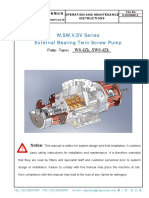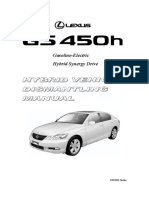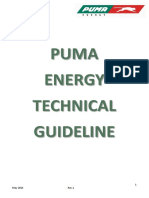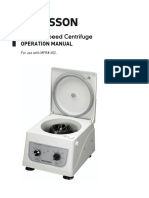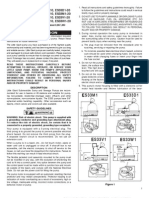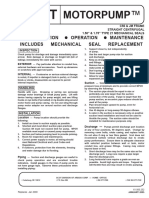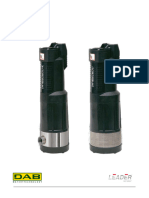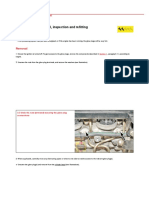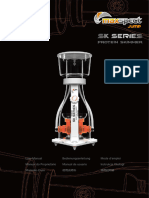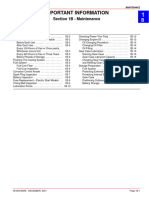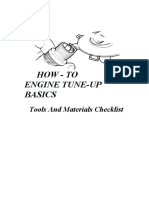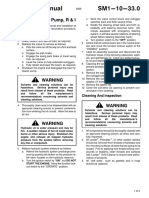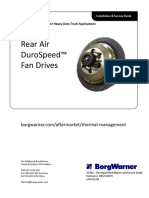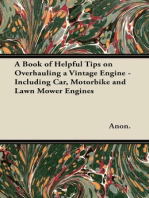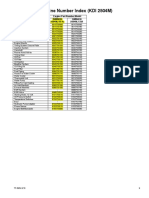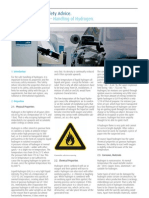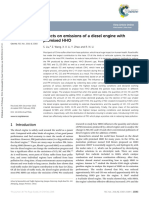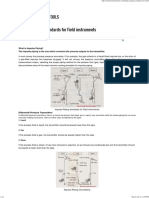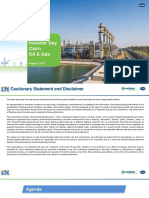Pages From Rescue Boat Engine Mercury 25
Pages From Rescue Boat Engine Mercury 25
Uploaded by
Prajesh T VCopyright:
Available Formats
Pages From Rescue Boat Engine Mercury 25
Pages From Rescue Boat Engine Mercury 25
Uploaded by
Prajesh T VOriginal Title
Copyright
Available Formats
Share this document
Did you find this document useful?
Is this content inappropriate?
Copyright:
Available Formats
Pages From Rescue Boat Engine Mercury 25
Pages From Rescue Boat Engine Mercury 25
Uploaded by
Prajesh T VCopyright:
Available Formats
MAINTENANCE
Inspection and Maintenance Schedule
Before Each Use
1. Check that lanyard stop switch stops the engine.
2. Visually inspect the fuel system for deterioration or leaks.
3. Check outboard for tightness on transom.
4. Check steering system for binding or loose components.
5. Visually check steering link rod fasteners for proper tightness.
6. Check propeller blades for damage.
After Each Use
1. Flush out the outboard cooling system if operating in salt or polluted water.
2. Wash off all salt deposits and flush out the exhaust outlet of the propeller and gear
case with fresh water if operating in salt water.
Every 100 Hours of Use or Once Yearly, Whichever Occurs First
1. Lubricate all lubrication points. Lubricate more frequently when used in salt water.
2. Inspect and clean spark plugs.
3. Check fuel line filter for contaminants.
4. Check carburetor adjustments, if required.
5. Check corrosion control anodes. Check more frequently when used in salt water.
6. Drain and replace gear case lubricant.
7. Lubricate splines on the drive shaft.∗
8. Electric start models – Inspect battery.
9. Remote control models – Check control cable adjustments.∗
10. Remove engine deposits with Power Tune Engine Cleaner.
11. Check tightness of bolts, nuts, and other fasteners.
12. Clean fuel tank pick up filter.
Every 300 Hours of Use or Three Years
1. Replace water pump impeller (more often if overheating occurs or reduced water
pressure is noted).*
∗ These items should be serviced by an authorized dealer.
Page 1B-2 90-826883R03 NOVEMBER 2002
MAINTENANCE
Flushing The Cooling System
Flush the internal water passages of the outboard with fresh water after each use in salt,
polluted, or muddy water. This will help prevent a buildup of deposits from clogging the
internal water passages.
Use Flushing Attachment (P/N 44357A2) or equivalent.
WARNING
To avoid possible injury when flushing, remove the propeller. Refer to Propeller
Replacement.
1. Remove propeller (refer to Propeller Replacement). Install the flushing attachment so
the rubber cups fit tightly over the cooling water intake holes.
CAUTION
Never start or run your outboard (even momentarily) without water circulating
through the cooling water intake in the gear case to prevent damage to the water
pump (running dry) or overheating of the engine.
2. Attach a water hose to the flushing attachment. Turn on the water and adjust the flow
so water is leaking around the rubber cups to ensure the engine receives an adequate
supply of cooling water.
3. Start the engine and run it at idle speed in neutral shift position.
90-826883R03 NOVEMBER 2002 Page 1B-3
MAINTENANCE
4. Adjust water flow (if necessary) so excess water continues leaking out from around
the rubber cups to ensure the engine is receiving an adequate supply of cooling water.
5. Check for a steady stream of water flowing out of the water pump indicator hole. Con-
tinue flushing the outboard for 3 to 5 minutes, carefully monitoring water supply at all
times.
6. Stop the engine, turn off the water, and remove the flushing attachment. Reinstall the
propeller.
Fuel System
WARNING
Avoid serious injury or death from gasoline fire or explosion. Carefully follow all
fuel system service instructions. Always stop the engine and DO NOT smoke or
allow open flames or sparks in the area while servicing any part of the fuel sys-
tem.
Before servicing any part of the fuel system, stop engine and disconnect the battery. Drain
the fuel system completely. Use an approved container to collect and store fuel. Wipe up
any spillage immediately. Material used to contain spillage must be disposed of in an ap-
proved receptacle. Any fuel system service must be performed in a well ventilated area.
Inspect any completed service work for sign of fuel leakage.
Fuel Line Inspection
Visually inspect the fuel line and primer bulb for cracks, swelling, leaks, hardness or other
signs of deterioration or damage. If any of these conditions is found, the fuel line or primer
bulb must be replaced.
Engine Fuel Filter
Inspect the sight bowl for water accumulation and inspect the filter element for sediment.
Clean filter as follows.
REMOVAL
1. Hold onto the cover to prevent it from turning.
2. Turn off the sight bowl.
3. Pull out the filter element and wash it with cleaning solvent.
Page 1B-4 90-826883R03 NOVEMBER 2002
MAINTENANCE
INSTALLATION
1. Push the filter element (with open end toward cover) into cover.
2. Place the O-ring seal into the sight bowl and screw the sight bowl hand tight into the
cover.
a - Cover
b - Filter Element
c - O-Ring
d - Sight Bowl
3. Visually inspect for fuel leakage around the sight bowl by squeezing the primer bulb
until firm, forcing fuel into the sight bowl.
Corrosion Control Anode
Your outboard has a corrosion control anode installed on the gear case. An anode helps
protect the outboard against galvanic corrosion by sacrificing its metal to be slowly eroded
instead of the outboard metals.
The anode requires periodic inspection especially in salt water which will accelerate the
erosion. To maintain this corrosion protection, always replace the anode before it is com-
pletely eroded. Never paint or apply a protective coating on the anode as this will reduce
effectiveness of the anode.
a - Anode
90-826883R03 NOVEMBER 2002 Page 1B-5
MAINTENANCE
Spark Plug Inspection
Inspect spark plugs at the recommended intervals.
1. Remove the spark plug leads by twisting the rubber boots slightly and pull off.
2. Remove the spark plugs to inspect and clean. Replace spark plug if electrode is worn
or the insulator is rough, cracked, broken, blistered or fouled.
3. Set the spark plug gap. See Specification Chart in General Information Section.
4. Before reinstalling spark plugs, clean away dirt on the spark plug seats. Install plugs
finger tight, and tighten 1/4 turn or torque to 20 lb. ft. (27.1 N·m).
Battery Inspection
The battery should be inspected at periodic intervals to ensure proper engine starting
capability.
IMPORTANT: Read the safety and maintenance instructions which accompany
your battery.
1. Turn off the engine before servicing the battery.
2. Add water as necessary to keep the battery full.
3. Make sure the battery is secure against movement.
4. Battery cable terminals should be clean, tight, and correctly installed. Positive to posi-
tive and negative to negative.
5. Make sure the battery is equipped with a nonconductive shield to prevent accidental
shorting of battery terminals.
Page 1B-6 90-826883R03 NOVEMBER 2002
MAINTENANCE
Fuse Replacement – Electric Start Remote Control Models
The electric starting circuit is protected from overload by a SFE 20 AMP fuse. If the fuse
is blown, the electric starter motor will not operate. Try to locate and correct the cause of
the overload. If the cause is not found, the fuse may blow again. Replace the fuse with
a fuse of the same rating.
Replace with a new SFE 20 AMP fuse.
Lubrication Points
Lubricate Points 1 through 6 with 2-4-C with Teflon or Special Lubricant 101.
1. Steering Friction Adjustment Shaft (Tiller Handle Models) – Lubricate fitting.
2. Swivel Bracket – Lubricate fitting.
3. Transom Clamp Screws – Lubricate threads.
90-826883R03 NOVEMBER 2002 Page 1B-7
MAINTENANCE
4. Tilt Tube – Lubricate fittings.
5. Lubricate the throttle and shaft cables, moving components and pivot locations.
5
WARNING
The end of the steering cable must be fully retracted into the outboard tilt tube
before adding lubricant. Adding lubricant to steering cable when fully extended
could cause steering cable to become hydraulically locked. An hydraulically
locked steering cable will cause loss of steering control, possibly resulting in
serious injury or death.
6. Steering Cable Grease Fitting (If Equipped) – Rotate steering wheel to fully retract the
steering cable end (a) into the outboard tilt tube. Lubricate through fitting (b).
Lubricate points 7 With Light Weight Oil
7. Steering Link Rod Pivot Points – Lubricate points.
6-b 6-a
Page 1B-8 90-826883R03 NOVEMBER 2002
MAINTENANCE
Lubricate Point 8 with Anti-Corrosion Grease or 2-4-C with Teflon.
8. Propeller Shaft – Refer to Propeller Replacement for removal and installation of the
propeller. Coat the entire propeller shaft with lubricant to prevent the propeller hub
from corroding to the shaft.
Gear Case Lubrication
Gear Case Lubricant Capacity
Gear Case Ratio Capacity
2.25:1 8.8 fl. oz. (260.0 ml)
Draining Gear Case
When adding or changing gear case lubricant, visually check for the presence of water
in the lubricant. If water is present, it may have settled to the bottom and will drain out prior
to the lubricant, or it may be mixed with the lubricant, giving it a milky colored appearance.
If water is noticed, have the gear case checked by your dealer. Water in the lubricant may
result in premature bearing failure or, in freezing temperatures, will turn to ice and damage
the gear case.
Whenever you remove the fill/drain plug, examine the magnetic end for metal particles.
A small amount of metal filings or fine metal particles indicates normal gear wear. An ex-
cessive amount of metal filings or larger particles (chips) may indicate abnormal gear
wear and should be checked by an authorized dealer.
90-826883R03 NOVEMBER 2002 Page 1B-9
MAINTENANCE
Draining Gear Case
1. Place outboard in a vertical operating position.
2. Place drain pan below outboard.
3. Remove fill/drain plug (a) and vent plug (b) and drain lubricant.
a - Fill/Drain Plug
b - Vent Plug
Checking Lubricant Level and Refilling Gear Case
1. Place outboard in a vertical operating position.
2. Remove vent plug from vent hole (a).
3. Place lubricant tube into the fill hole (b) and add lubricant until it appears at the vent
hole (a).
a - Fill/Drain Plug
b - Vent Plug
4. Stop adding lubricant. Install the vent plug and sealing washer before removing the
lubricant tube.
Page 1B-10 90-826883R03 NOVEMBER 2002
MAINTENANCE
5. Remove lubricant tube and reinstall cleaned fill/drain plug and sealing washer.
Storage Preparations
Fuel System
IMPORTANT: Gasoline containing alcohol (ethanol or methanol) can cause a for-
mation of acid during storage and can damage the fuel system. If the gasoline be-
ing used contains alcohol, it is advisable to drain as much of the remaining gaso-
line as possible from the fuel tank, remote fuel line, and engine fuel system.
Fill the fuel system (tank, hoses, fuel pumps, and fuel injection systems) with treated (sta-
bilized) fuel to help prevent formation of varnish and gum. Proceed with following instruc-
tions.
1. Portable Fuel Tank – Pour the required amount of Gasoline Stabilizer (follow instruc-
tions on container) into fuel tank. Tip fuel tank back and forth to mix stabilizer with the
fuel.
2. Permanently Installed Fuel Tank – Pour the required amount of Gasoline Stabilizer
(follow instructions on container) into a separate container and mix with approximate-
ly one quart (one liter) of gasoline. Pour this mixture into fuel tank.
3. Place the outboard in water or connect flushing attachment for circulating cooling
water. Run the engine for ten minutes to allow treated fuel to fill the fuel system.
Protecting External Engine Components
1. Lubricate all outboard components listed in the Inspection and Maintenance
Schedule.
2. Touch up any paint nicks.
3. Spray Corrosion Guard on external metal surfaces (except corrosion control anodes).
90-826883R03 NOVEMBER 2002 Page 1B-11
MAINTENANCE
Protecting Internal Engine Components
NOTE: Before performing Steps 1 and 2, make sure the fuel system has been prepared
for storage.
1. Place the outboard in water or connect flushing attachment for circulating cooling
water. Start the engine and let it run in neutral to warm up.
2. With engine running at fast idle, stop the fuel flow by disconnecting the remote fuel
line. When engine begins to stall, quickly spray Storage Seal Rust Inhibitor into carbu-
retor until engine stops from lack of fuel.
3. Remove the spark plugs and inject a five second spray of Storage Seal Rust Inhibitor
around the inside of each cylinder.
4. Rotate the flywheel manually several times to distribute the storage seal in the cylin-
ders. Reinstall spark plugs.
Gear Case
Drain and refill the gear case lubricant (refer to maintenance procedure).
Positioning Outboard for Storage
Store outboard in an upright position to allow water to drain out of outboard.
CAUTION
If outboard is stored tilted up in freezing temperature, trapped cooling water or
rain water that may have entered the propeller exhaust outlet in the gear case
could freeze and cause damage to the outboard.
Battery Storage
1. Follow the battery manufacturers instructions for storage and recharging.
2. Remove the battery from the boat and check water level. Recharge if necessary.
3. Store the battery in a cool, dry place.
4. Periodically check the water level and recharge the battery during storage.
Page 1B-12 90-826883R03 NOVEMBER 2002
You might also like
- Komatsu Engine 102 Series Workshop ManualsDocument20 pagesKomatsu Engine 102 Series Workshop Manualsearl100% (62)
- 4990 Cargo Pump ManualDocument32 pages4990 Cargo Pump ManualPrajesh T VNo ratings yet
- GS450H HybridDocument32 pagesGS450H HybridAdam BorowskiNo ratings yet
- 201405XX - MAN - Puma Energy Technical Manual 2014Document201 pages201405XX - MAN - Puma Energy Technical Manual 2014Cesar BernalNo ratings yet
- Mercury Maintenance ManualDocument27 pagesMercury Maintenance ManualJens Adam Hedegaard HansenNo ratings yet
- MaintenanceInformation OptiMaxDocument20 pagesMaintenanceInformation OptiMaxcombaheeNo ratings yet
- 0911 Maintenance 15FSDocument23 pages0911 Maintenance 15FSemilio275655No ratings yet
- 0911 Maintenance-8to9 9FSDocument20 pages0911 Maintenance-8to9 9FSLahiru Chamara JayasingheNo ratings yet
- Manual de Usuario de Centrifuge McKessonDocument6 pagesManual de Usuario de Centrifuge McKessonfoxhoundforces100% (1)
- Maintenance: Outboard CareDocument18 pagesMaintenance: Outboard Careshygal1981100% (1)
- TOBUL TMpiston Sheet080309v1Document4 pagesTOBUL TMpiston Sheet080309v1alainraadNo ratings yet
- Maintenance Guide For VTLFDocument18 pagesMaintenance Guide For VTLFrubinisilvaNo ratings yet
- Little Giant ES33 Submersible Sump Effluent Pumps ManualDocument12 pagesLittle Giant ES33 Submersible Sump Effluent Pumps ManualOsvaldo EscatelNo ratings yet
- Waterfall Pump 1650 2300Document20 pagesWaterfall Pump 1650 2300kobelco2567No ratings yet
- Important Information: Section 1B - MaintenanceDocument14 pagesImportant Information: Section 1B - MaintenanceDr. Centelha Mecânica NaúticaNo ratings yet
- AC4 - AC5 Horizntal Series ManualDocument8 pagesAC4 - AC5 Horizntal Series ManualDaniel RibeiroNo ratings yet
- Mercury 115 Manual 1bDocument13 pagesMercury 115 Manual 1bMomed MdNo ratings yet
- M25 PumpDocument4 pagesM25 PumpvmontoyaNo ratings yet
- Z8 (CF800) Service Manual 2013 (057-211) (037-150)Document114 pagesZ8 (CF800) Service Manual 2013 (057-211) (037-150)francisco jose ramirez perezNo ratings yet
- Procedure of Maintenance of DG SETDocument8 pagesProcedure of Maintenance of DG SETVatsavai Appala Narasimha RajuNo ratings yet
- Caterpillar 3208Document8 pagesCaterpillar 3208lcampagnoliNo ratings yet
- Bomba Myers D35-20DVDocument12 pagesBomba Myers D35-20DVdiroperacionesNo ratings yet
- Cooling TowerDocument9 pagesCooling TowerShanooziya KhanNo ratings yet
- DIVERTRON InstructionsDocument8 pagesDIVERTRON InstructionsPatrik TurcsekNo ratings yet
- Steam Condensate Return Unit ManualDocument8 pagesSteam Condensate Return Unit ManualAnonymous 7xHNgoKE6eNo ratings yet
- MODELS: G 1006T/SS316: Operating Instructions, Installation & Maintenance Manual Including Spare Parts ListDocument13 pagesMODELS: G 1006T/SS316: Operating Instructions, Installation & Maintenance Manual Including Spare Parts ListjaimeNo ratings yet
- G554T-Manual-1.5, 10HPDocument21 pagesG554T-Manual-1.5, 10HPMohan CharanchathNo ratings yet
- 2 Glow Plugs - Removal, Inspection and RefittingDocument4 pages2 Glow Plugs - Removal, Inspection and RefittingNacho Hernández YlleraNo ratings yet
- MJ SK Series Protein Skimmer User Manual v2Document112 pagesMJ SK Series Protein Skimmer User Manual v2rodrigofsmNo ratings yet
- Swing-Flex Check Valve: Operation, Maintenance and Installation ManualDocument8 pagesSwing-Flex Check Valve: Operation, Maintenance and Installation ManualAhmed ShawkyNo ratings yet
- Airboat - Operators ManualDocument11 pagesAirboat - Operators ManualMichael HallNo ratings yet
- Removing The Original Master CylinderDocument5 pagesRemoving The Original Master Cylindersharawy12No ratings yet
- Walk Around InspectionDocument3 pagesWalk Around InspectionshivNo ratings yet
- Important Information: Section 1B - MaintenanceDocument17 pagesImportant Information: Section 1B - MaintenanceDr. Centelha Mecânica NaúticaNo ratings yet
- Manual For Aux BlowerDocument39 pagesManual For Aux BlowerBarışgün EvrenüzNo ratings yet
- Hoses and ClampsDocument6 pagesHoses and ClampsshivNo ratings yet
- Owner'S Service Manual NO. 05607 Inspection, Maintenance and RechargeDocument6 pagesOwner'S Service Manual NO. 05607 Inspection, Maintenance and RechargeNego1975No ratings yet
- How - To Engine Tune-Up Basics: Tools and Materials ChecklistDocument6 pagesHow - To Engine Tune-Up Basics: Tools and Materials ChecklistEdz CabrigaNo ratings yet
- Instruction Sheet: Mechanical Seal ReplacementDocument2 pagesInstruction Sheet: Mechanical Seal ReplacementMantenimiento LohmannNo ratings yet
- Red Lion-Wc50ta-Owners-Manual-06-11 PDFDocument8 pagesRed Lion-Wc50ta-Owners-Manual-06-11 PDFMaquinas IndexNo ratings yet
- Water Pump Fitting Instructions: Monteringsvejledning VandpumpeDocument2 pagesWater Pump Fitting Instructions: Monteringsvejledning VandpumpehermanNo ratings yet
- Model 45HB-70HB: Instruction ManualDocument12 pagesModel 45HB-70HB: Instruction ManualcarlosNo ratings yet
- Service Manual SM1-10-33.0: Outrigger/Steer Pump, R & IDocument4 pagesService Manual SM1-10-33.0: Outrigger/Steer Pump, R & IMohamed RashedNo ratings yet
- SM01 010 033.00 PDFDocument4 pagesSM01 010 033.00 PDFMohamed RashedNo ratings yet
- JuicePump 50 UL Maintenance ManualDocument8 pagesJuicePump 50 UL Maintenance Manualcvbnm9527No ratings yet
- SR4 Generator & Control Panel MaintenanceDocument7 pagesSR4 Generator & Control Panel MaintenancejavierNo ratings yet
- Kewpump - Ks-Se3 Operation Manual PDFDocument7 pagesKewpump - Ks-Se3 Operation Manual PDFAnonymous T7zEN6iLHNo ratings yet
- 302-031 KV Iom PDFDocument7 pages302-031 KV Iom PDFShannah ShermanNo ratings yet
- Calibracion de Valvulas.Document3 pagesCalibracion de Valvulas.Enso RosalesNo ratings yet
- Section 2 - Periodic Maintenance/Tune-Up: Table ofDocument20 pagesSection 2 - Periodic Maintenance/Tune-Up: Table oftafseerahmadNo ratings yet
- York Chiller - Maintenance RequirementsDocument3 pagesYork Chiller - Maintenance RequirementsZahin BasriNo ratings yet
- Valve/Tappet Clearance Valve/Tappet Clearance: ! CautionDocument2 pagesValve/Tappet Clearance Valve/Tappet Clearance: ! CautionVenkatNo ratings yet
- Tilt CylinderDocument7 pagesTilt Cylinderluis tocoraNo ratings yet
- Swimming Pool Filter Pump ManualDocument8 pagesSwimming Pool Filter Pump ManualEDWIN MUÑOZNo ratings yet
- Rev A Durospeed GuideDocument15 pagesRev A Durospeed GuideCamilo Arroyave JNo ratings yet
- 26850A005Document12 pages26850A005Luciano AlencastroNo ratings yet
- Manual 1956 PN 09-1013 VF-61Document3 pagesManual 1956 PN 09-1013 VF-61fabiosparkNo ratings yet
- Deltech Controls, L.L.C.: Delval Flow Controls Private LimitedDocument8 pagesDeltech Controls, L.L.C.: Delval Flow Controls Private LimitedProcess Controls & ServicesNo ratings yet
- RT440B ENG Rev.01 - 2007 (1) (099-248)Document150 pagesRT440B ENG Rev.01 - 2007 (1) (099-248)Valmaq Prestação Serviço LdaNo ratings yet
- RT440B ENG Rev.01 - 2007 (1) (099-248) (001-079)Document79 pagesRT440B ENG Rev.01 - 2007 (1) (099-248) (001-079)Nelson ConselhoNo ratings yet
- Magnum ManualDocument2 pagesMagnum ManualTiffany DacinoNo ratings yet
- Manual Model E45Document8 pagesManual Model E45Beni WibowoNo ratings yet
- A Book of Helpful Tips on Overhauling a Vintage Engine - Including Car, Motorbike and Lawn Mower EnginesFrom EverandA Book of Helpful Tips on Overhauling a Vintage Engine - Including Car, Motorbike and Lawn Mower EnginesRating: 5 out of 5 stars5/5 (1)
- Generator SetsDocument2 pagesGenerator SetsPrajesh T VNo ratings yet
- Parts Manual For - 20.5EFKOZD 9Document1 pageParts Manual For - 20.5EFKOZD 9Prajesh T VNo ratings yet
- Here Is What You Need To Know About Enhanced Survey ProgrammeDocument24 pagesHere Is What You Need To Know About Enhanced Survey ProgrammePrajesh T VNo ratings yet
- Sherwood Maintenance and Repair Manual - Jamestown DistributorsDocument48 pagesSherwood Maintenance and Repair Manual - Jamestown DistributorsPrajesh T VNo ratings yet
- Handling of Hydrogen172 - 72941 PDFDocument4 pagesHandling of Hydrogen172 - 72941 PDFkapil1979No ratings yet
- Analysis of Exhaust Gas Waste Heat Recovery and Pollution Processing For Z12V190 Diesel EngineDocument8 pagesAnalysis of Exhaust Gas Waste Heat Recovery and Pollution Processing For Z12V190 Diesel EngineManishGuptaNo ratings yet
- Engine Specification EC210B-ENG1-01 Description of Nameplate EC210B-ENG1-02 Nameplate & Serial Number EC210B-ENG1-03Document11 pagesEngine Specification EC210B-ENG1-01 Description of Nameplate EC210B-ENG1-02 Nameplate & Serial Number EC210B-ENG1-03U Wang TinNo ratings yet
- Effects On Emissions of A Diesel Engine With Premixed HHODocument7 pagesEffects On Emissions of A Diesel Engine With Premixed HHONam stareNo ratings yet
- Impulse Tubing InstrumentsDocument2 pagesImpulse Tubing InstrumentssuhailfarhaanNo ratings yet
- CV - Muhammad Marco SayputraDocument1 pageCV - Muhammad Marco SayputraMuhammad Marco SayputraNo ratings yet
- Fossil FuelsDocument8 pagesFossil Fuelsapi-293431691100% (1)
- Form Bunker SurveyDocument10 pagesForm Bunker SurveyMuchtar Asy-SyathiriNo ratings yet
- Boiler Powerpoint 2003Document70 pagesBoiler Powerpoint 2003Sahil Mishra100% (3)
- Engine CoolingDocument7 pagesEngine CoolingpradipNo ratings yet
- TM 10 3930 618 24PDocument306 pagesTM 10 3930 618 24PRyan FuerteNo ratings yet
- Horno P&ID Refineria YPFBDocument1 pageHorno P&ID Refineria YPFBJhoana Hurtado CáceresNo ratings yet
- Regenerative Pumps For NPSHRDocument4 pagesRegenerative Pumps For NPSHRChem.EnggNo ratings yet
- BC-244 NewDocument5 pagesBC-244 NewLuis Alberto Lopez100% (1)
- Sensors Used in CarsDocument14 pagesSensors Used in Cars2031 Ayush KshirsagarNo ratings yet
- 143343eaa75261a94b8dc219e4ccb606Document15 pages143343eaa75261a94b8dc219e4ccb606Deanna BarrettNo ratings yet
- Commutator (DC Machines) 1Document29 pagesCommutator (DC Machines) 1adevirgieNo ratings yet
- Investor Day 2019 - Cairn Oil GasDocument43 pagesInvestor Day 2019 - Cairn Oil Gasmd.muneerNo ratings yet
- Master Fire Fighting BoqDocument15 pagesMaster Fire Fighting Boqhussam_980% (1)
- Cummins Isde245 30 So40149 Parts CatalogueDocument10 pagesCummins Isde245 30 So40149 Parts CatalogueChen Caroline100% (1)
- Synopsis Wind Mill ProjectDocument4 pagesSynopsis Wind Mill ProjectSandip Ghadge80% (5)
- Gas Processing and NGL ExtractionDocument132 pagesGas Processing and NGL ExtractionRicardo Yashin Távara La Chira100% (5)
- Morse Test FinalDocument31 pagesMorse Test FinalItemogeng Bernatt BabeNo ratings yet
- Fuels and Combustion MCQs PDFDocument55 pagesFuels and Combustion MCQs PDFZubair Malik75% (8)
- Power Generator For MT-8BDocument60 pagesPower Generator For MT-8BTyan ScreamouscoreNo ratings yet
- Ic Engine Project ReportDocument6 pagesIc Engine Project ReportAtulkumarSutharNo ratings yet
- Basics of Reforming, Shapes and Carbon WSVDocument28 pagesBasics of Reforming, Shapes and Carbon WSVMuhammad NaeemNo ratings yet

